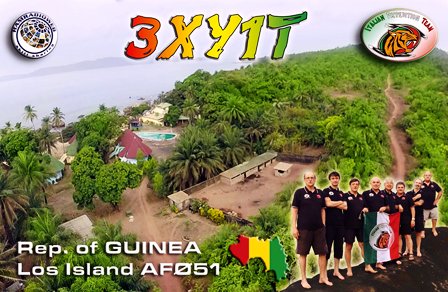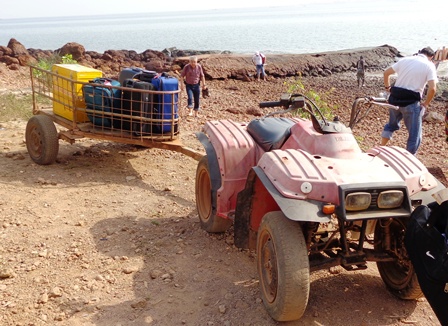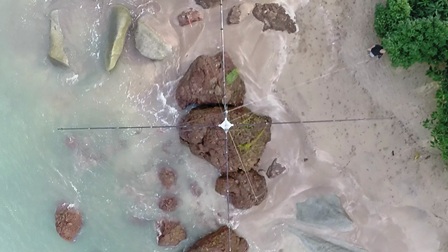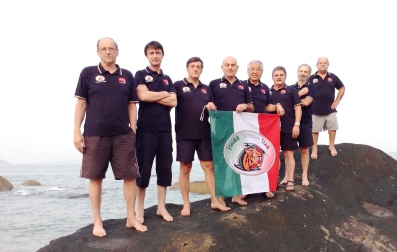Rep. of Guinea 3XY1T
3XY1T … all together, for the first time !
Over 91,000 contacts, of which 1700 on 160m and more than 10,000 on 40m, with almost 27,000 uniques: a major achievement ! This is the starting point for our account of the last African adventure staged by the Italian DXpedition Team. And one more “unique”: it was the first time that , owing to a lucky set of circumstances, all Team members were able to participate in the DXpedition. Being all together, sharing our DX enthusiasm, was the key to our most rewarding achievement.
It all began in June 2015, when, on returning from Kenya, Silvano and Stefano started a search for the location of a future DXpedition for November of the same year. Looking at the map of Africa, by now a well-known continent for us, and taking into account the available statistics on the “most wanted” countries, we identified a small State: the Republic of Guinea.
One must take into account that there exist several Guineas: besides the Republic of Guinea, one can find in Africa also Guinea Bissau and Equatorial Guinea, not mentioning Papua New Guinea in the Pacific. A jumble of Guineas that, at first sight, may seem confusing: some our friends were a little puzzled about which Guinea was to be our destination. In order to make it clear, we called it Guinea Conakry from the name of its Capital city.
At this point, scanning the Atlantic coast of this country we noticed a small island group having a IOTA reference, Los island AF051. After analyzing in depth the morphological structure of the islands and the availability of accommodation facilities, we finally chose Kassa island, in the Los group. It is the closest island to the mainland, easy to reach but unfortunately without a power grid.
The island population is about one hundred people, mostly fishermen, and there is only one lodge with bungalows, restaurant and meeting room. The structure is run by Pascal, of French origin but in Guinea since 30 years, and his partner Samo, of Chinese origin. The resort is equipped with a generator, which operates only during nighttime; during the day a limited amount of electrical power is provided by solar panels. We had therefore to get organized with a pair of generators, used alternatively during the day, and relying on the local generator at night.
As usual, we looked for a resident to act as a middleman with local authorities for licensing and custom formalities at the airport. To this end, we consulted with DL7DF Sigi and DL7UFR Frank, who activated Guinea some years ago. With great Ham Spirit they replied quickly and got us in touch with Ibrahima Khalil Sow, a local ham who offered his services. After an initial hesitation, we found in Ibrahima a most precious and even irreplaceable organizer: for the first time we did not have any problems or worries. Throughout the period of our stay he was available full-time, solving all bureaucratic or logistic issues for us. Without him everything would have been much more difficult.
Our aim was to operate from Guinea in November, but setbacks are the norm. We realized later, in fact, that the new Presidential elections were scheduled in October and Ibrahima suggested that it would be wise, for obvious safety reasons, to wait for the outcome. We then delayed our plans to the second half of February; it was a lucky shot, since in this case all Team members confirmed their participation in this adventure.
It was very nice to be all together for the first time, which allowed us to plan our journey to the best. In addition, it was easier for Silvano to organize and manage the considerable number of crates and boxes to be carried with us. For once, we even had some extra weight available for our personal baggage, almost unbelievable! Obviously, this extra allowance was immediately used up with additional antennas, particularly for low-band reception.
On arrival, Pascal informed us that, for practical reasons, we could not set up the stations in our rooms. We therefore had to rent the meeting room of the resort, thus locating all station in the same ambience. We were somewhat worried of the SSB operators disturbing the CW ones. This turned out not to be the case, with thoughtful distribution of the different activates across the room. On the contrary, this choice added flexibility, with stations switching to different antennas and modes beyond the original planning. In the end, this also payed off considerably.
Guinea can be reached through different routes. Choosing, as usual, the most inexpensive solution, we flew Air France from Milano to Conakry via Paris and Nouatchott in Mauritania. Departure on 17 February in the morning, and arrival late afternoon on the same day. Sailing at dusk not being recommended there because of tides, on arrival we had to stay overnight in the Capital city and we left for the island the following morning.
We were surprised when we saw our boat. We were not expecting an offshore powerboat, but neither a pirogue with a 10HP engine… taming the Atlantic Ocean with such a small boat is not an every day’s experience. Anyway, this was the transportation available and, after donning our life jackets, we trusted to luck. The stretch of sea between Conakry and Kassa island was calm, and with a number of stops due to a slipping gear in the engine (not uncommon for that boat) we finally landed on AF051 at 10:00 local on 18 February 2016.
After occupying our rooms, we began immediately the setting up of stations and antennas, plus LAN and internet connection. No one doubted Mr Murphy, who showed up on schedule: what was supposed to be a high speed 3G connection, in reality turned out to be at the level of smoke signals. Having faced Mr Murphy so many times we were well prepared, and finally our real-time online log was operational since the very first QSO, with just a few breaks from time to time.
What had happened was that we had charged Ibrahima with the task of solving the problem, and in the end we had to purchase modems from different providers, in order to achieve a suitable working mix according to needs. We had even planned a live camera streaming with audio from the CW and SSB stations, but this proved to be beyond the limitations of the internet connection. Next time !
The first station to be on air was the RTTY one, operated by IK2RZP Gino who, craving for contacts, stepped straight into the pileup. Our choice was to operate in this mode on just one band, 15m, which allowed also the “little pistols” to log 3XY on this mode. Only during the last two days our strategist Silvano, under pressure by Gino, agreed to make a “handful” of contacts on 30m: we logged 1000 QSOs! There had been in fact a strong request for RTTY, since 3XY had never been active on this mode before. We shall analyze our log to check how many stations worked us on RTTY on both bands, in order to understand and plan better for the future.
The RTTY station was then followed by the SSB station operated by JA3USA Mac, who immediately reached a “ionosphere warming level” with his JA and USA pileups. Following it the CW station, turned on in the evening already on the lower bands.
The overall operating setup consisted of one station for SSB, one for CW, one for RTTY and a fourth one operating 6m and as a “jolly”. 6m was the only band which produced unsatisfactory results, but this was expected. Every day Sergio IK0FTA kept us informed about possible openings and we did not miss one, but in practice they were limited to short bursts of propagation which allowed just a handful of sporadic contacts. As a consequence, this station was dedicated to SSB on the first week, and to CW on the second.
Once again we were surprised by the effectiveness of the I-PRO TRAVELLER vertical: set up on the beach in less than 5 minutes, it totaled almost 10,000 QSOs. We could hardly believe the strength of the signals from USA and Japan, a remarkable performance for such a small and simple antenna which at times proved superior to our Spiderbeams. Maybe a factor of takeoff angle, important over long distances, or location just above the water level. It worked perfectly!
The great surprise – and satisfaction – came from the lower bands: more than 10,000 contacts on 40m, of which 4449 on CW and 5951 on SSB. On 80m 1848 QSOs with the USA, and finally 1714 contacts on 160m. What is really gratifying is that these numbers were obtained without super antennas or very high power: we operated with Elecraft KPA500 linear amplifiers at 500W maximum power. Often we reduced power in order to minimize interference to our other stations.
The transmitting antennas were the usual ones: a full-size wire vertical for 40m, a shortened vertical for 80mwith 4 x 1/2 lambda radials for both, and a vertical for 30m. On the 160m band we set up a vertical with capacitive hat, which refused stubbornly to work properly. Thanks also to the precious advice of Lucio IW2FND, we finally built a tuning network which allowed a 1.1 match and everything worked perfectly. 
This problem arose, in our opinion, from the peculiar nature of the ground: the island is no less than a big chunk of bauxite and granite surrounded by saltwater, which improved the performance of our antennas. Also, the scarcity of electrical equipment on the island reduced the noise to a minimum, contrary to what we normally experienced in Africa, allowing the use of our verticals also for receiving.
In this respect, we wish to report our field experience in comparing different antenna types. Alfeo I1HJT had prepared different antenna setups: 2 phased verticals mod. H1-Z 2 , a double loop LZ1AQ, a DHDL and a diamond loop. We did not consider Beverages, owing to lack of adequate free space for 200m (or more) long wires.
For those who are interested in more details, Alfeo is preparing a presentation which will be made available also on the web. For the moment, suffice it to say that the best results were obtained with the DHDL and the Diamond loop. It is well known, however, that these results may vary considerably according to location and direction of the received signals. We could switch these antennas from the shack, and could also connect them through a splitter to the CW and SSB stations, which could then use these RX antennas. This turned out not to be necessary, though, thanks to the very low noise level which rendered receiving on the verticals very effective.
Overall, optimal conditions on 20, 17 and 15 meters; somewhat less on 12 and 10 meters because of the declining solar cycle. Great openings in the morning to JA long-path, but no sign of the forecasted long-path openings to the West Coast on 12 and 10 meters. On the other hand, since sunset to deep night 15, 17 and 20m offered strong conditions to USA, while Europe was available non-stop during daylight.
We anticipated important numbers, but results exceeded expectations. Three days before the conclusion of operations, when we had already exceeded 83,000 QSOs, Silvano convened the Team and set a target at 90,000. It was the first time that we set an explicit objective, knowing the many variables and setbacks that may occur during a DXpedition with resulting disappointment, but we were so close to this aim and willing to test ourselves. We felt like a soccer team playing the final match in the world championships: we had to succeed. An ambitious target and a personal challenge always raise the bar.
We made it: when the online log displayed 90,000 we rejoiced and emails from many friends who were following live our race made this achievement a most gratifying one, something that can be well understood by those sharing our passion for radio and DXing.
A great appreciation goes to Marcello IK2DIA, who manned almost all nights on 40 and 80 meters SSB, and to Gino IK2RZP who bravely managed the heavy RTTY pileups, carrying out all QSOs from beginning to the end. Angelo IK2CKR displayed a superb skill in handling unbelievable CW pileups, a real art, and Vinicio IK2CIO who never faltered in spite of heavy consequences from the anti-malaric prophylaxis. A “bravo” to Mac JA3USA, who manages his JA pileups with elegance and perseverance in spite of a jet lag which can be hardly reabsorbed in the one week he can spend with us. Congratulations also to Alfeo I1HJT, who succeeded – at last – to fulfill his desire for intensive work on 80 and 160m, this last band being his preferred one. He surely gave a New One to many OMs, who are certainly grateful to him for that. No further mention of Stefano IK2HKT, who proved once more to be “the king” on SSB.
In the end all of us, we and you together, must extend our big THANKS to our “boss” Silvano I2YSB, for his ability to keep and foster a true Team spirit, as well as organizing perfectly our DXpeditions both before (planning), during (execution, strategy) and after the fact (QSLs, LoTW, DVDs …).
As always we are grateful to those supporting us, both financially and morally: friends, ARI Sections, Associations, firms and – last but not least – our families.
We rely on you also for the future … Silvano is already planning our new DXpedition !
